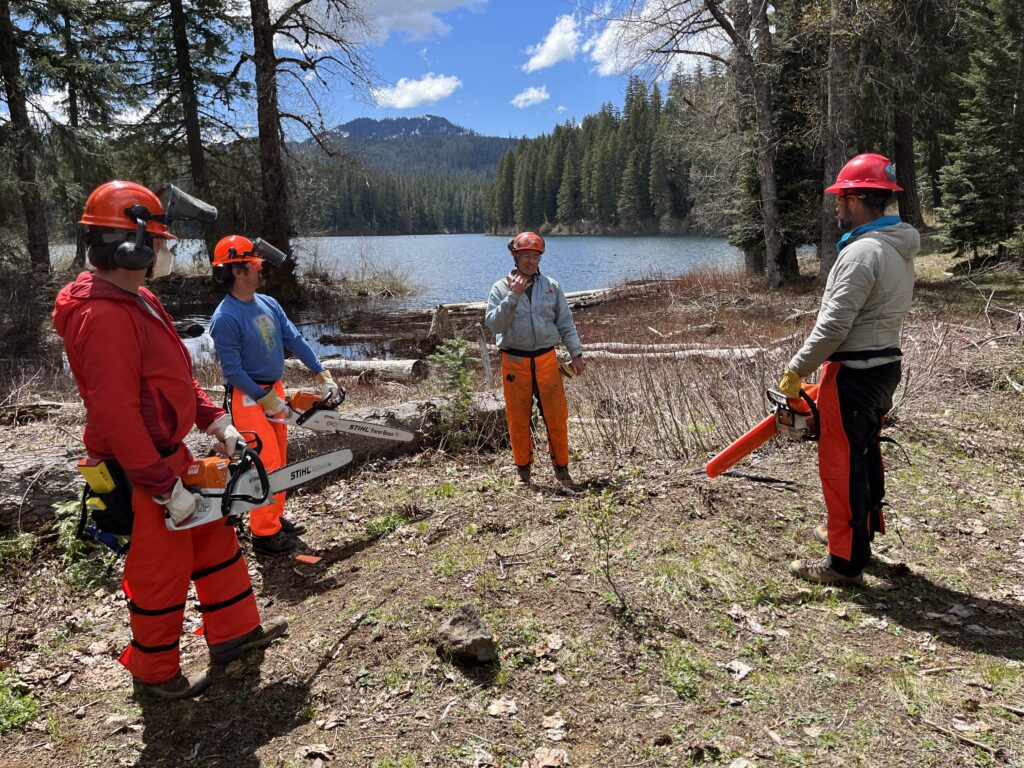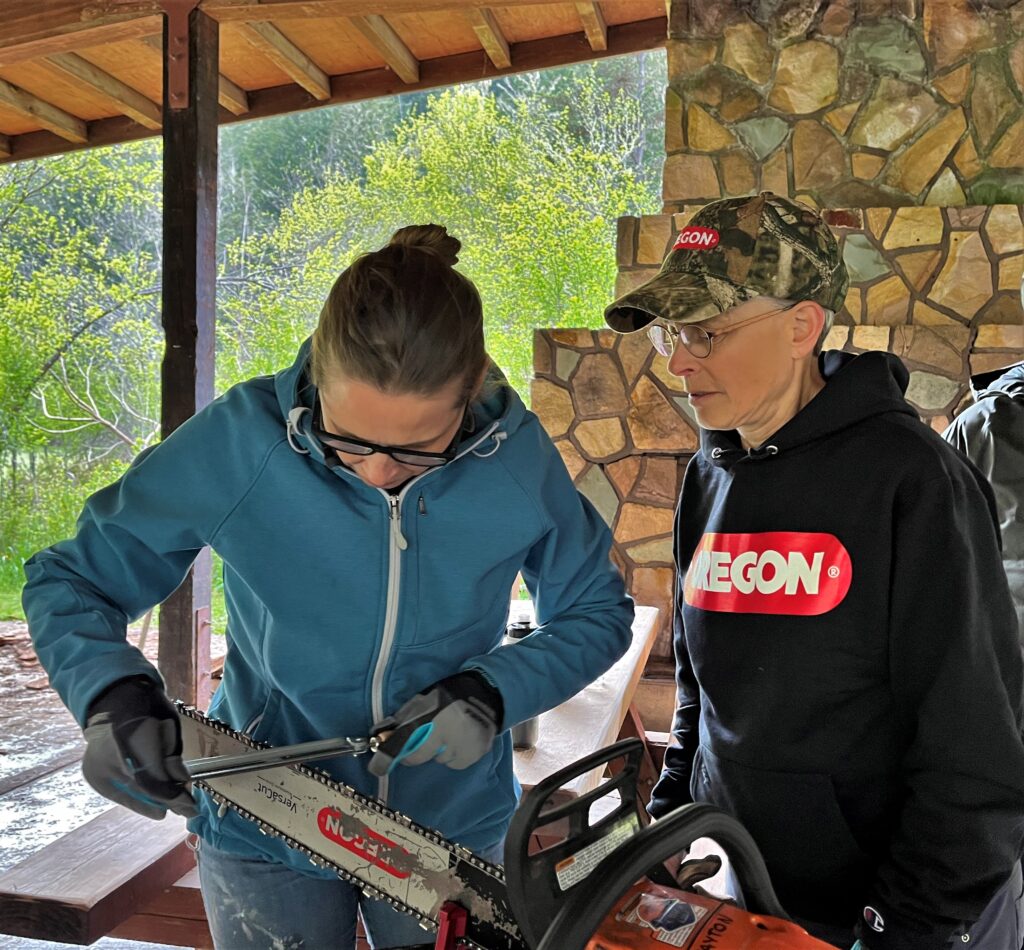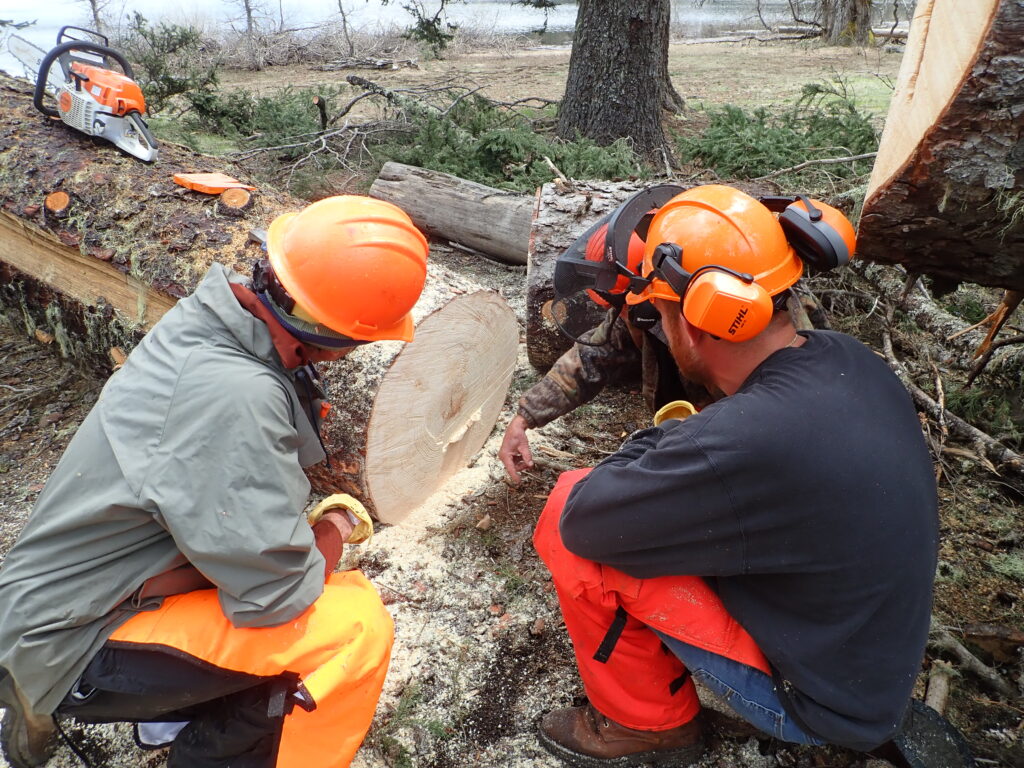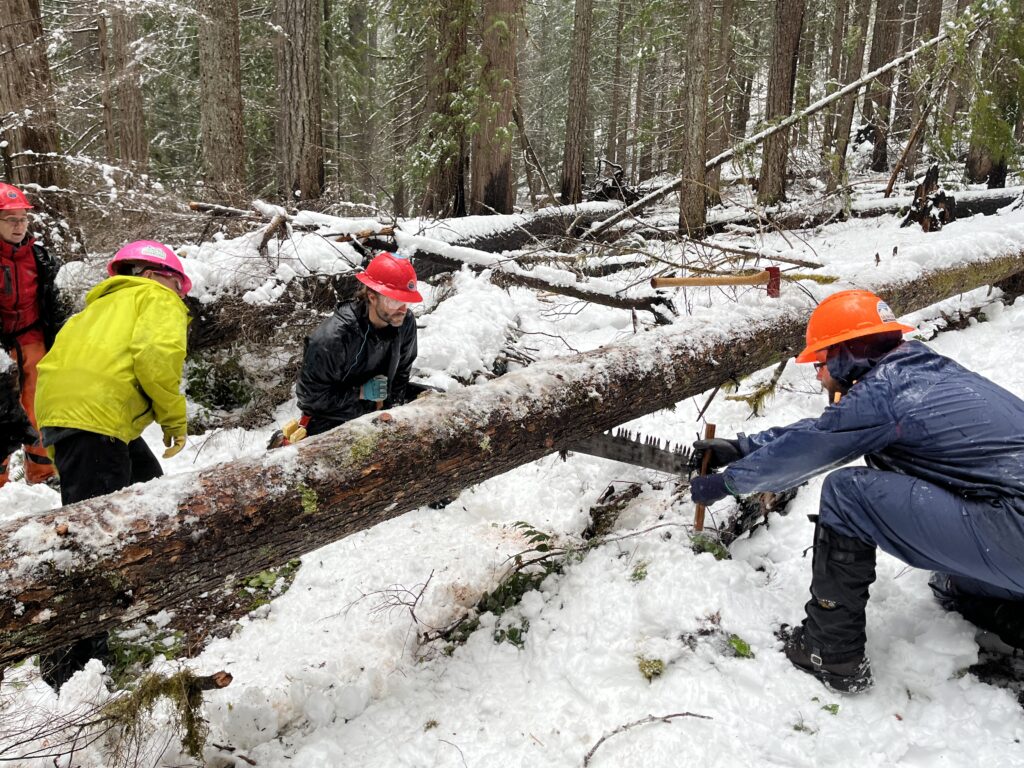
Volunteer Saw Partner Program
The Cascade Volunteers Saw Partner Program is a nationally recognized and approved sawyer training program. Our program is implemented by Forest Service volunteers who are certified as B or C Sawyer Evaluators who in turn can train and evaluate our own organization’s volunteers and Forest Service employees.
Cascade Volunteers Saw Program Coordinator, Beth Dayton: bethdayton@comcast.net
Saw class cost: You must first sign up for a class on Better Impact to assure a spot in the class. Making a donation does not reserve a spot in the class.
A donation is optional for volunteers. We suggest a $150 donation to support these programs that are run by volunteers. Those who are able to donate any amount will help us to continue providing these classes. You are considered a volunteer if you will primarily be running a saw as an unpaid volunteer.
You are considered Agency or Professional if you will be primarily running a saw as a paid employee of a government agency or business. For agency staff and professionals, the cost is $250 unless a different group rate is approved by the Saw Program Coordinator.
If you are organizing a group of trainees, contact the Saw Program Coordinator at bethdayton@comcast.net for the suggested donation.
After you sign up for a class on Better Impact, you will receive an email that includes details for making a donation, or you can go to the Cascade Volunteers Saw Program donation form.

National Saw Policy Summary
Sawyers whose saw card has expired may not cut on National Forest lands until they have undergone a one-day field re-evaluation and received a new card. In addition, all sawyers must maintain current First Aid and CPR cards. No sawyer may saw alone; an adult safety person is required to be present for all saw operations. Saw operations are defined as cutting any material over five inches in diameter, even if it is with a hand saw.
Amended National Saw Policy, effective March 2023: SawProgramUpdates

Saw Program FAQs
- What is the USFS Saw program? • The National Forest Saw Program was developed to facilitate the
safe use of chain saws and crosscut saws. The intent of the program is to provide the direction needed to optimize the critical skills needed by sawyers as they conduct saw operations on National Forest System (NFS) lands and ensure nationally consistent application of the Forest Service National Saw Policy (FSM 2358). - Who does the USFS saw policy apply to? • The National Saw Policy (FSM 2358) applies to all users of chain saws and crosscut saws on National Forest lands.
- Are hand saws covered under this policy? • Bow saws, pruning saws, brush saws, and pole saws are not covered in this policy unless they are used for cutting material larger than 5” in diameter.
- Are battery-powered saws covered under this policy? • Battery-powered saws are covered under this policy and must be equipped with the same safety components as a gasoline-powered saw, apart from a spark arrestor and vibration dampening.
- What are the different levels of sawyer certifications? • There are three levels of certifications for each type of saw (crosscut or chain saw):
- i. A-level sawyers may cut in the least complex situations and always under the direct supervision of a B or C-level sawyer.
- ii. B-level sawyers may cut in moderately complex situations and without higher-level supervision.
- iii. C-level sawyers may cut in the most complex situations.
- There is also a C sawyer evaluator level. These are highly qualified sawyers who have demonstrated they have the knowledge and skill to instruct and evaluate at the C sawyer level. They must maintain proficiency as a C-level sawyer.
- No sawyer may cut alone. An adult safety person must accompany the sawyer.
- Is it possible to be certified for Bucking only? • Sawyers may be certified as bucking only at any level and for both chain saws and crosscut saws. Volunteers may be certified for felling, but it is not commonly done as there is minimal need for felling during volunteer operations.
- How long will my saw certification card be valid? • Sawyer certifications are valid for three years from date of issuance and are valid on all National Forest System (NFS) lands. Re-certification requires a one-day field evaluation by a qualified evaluator. The card must then be certified (signed) as noted below.
- Is first aid and CPR required for all sawyers? • All saw operators must maintain a current first aid and CPR certification except for crosscut saw trainees who are operating under the supervision of another sawyer. We maintain a list of first aid and CPR classes here.
- What is the minimum age for sawyers? • Chain saw sawyers must be at least 18 years of age. Crosscut sawyers must be at least 16 years of age.
- Who needs to be trained? • Instruction must be though an approved FS training curriculum by a qualified instructor. The standard saw class requires one day of didactic instruction and one day of field practice and evaluation. Chainsaw sawyers may not operate on FS lands until they have gone through the standard training class and been certified. Crosscut sawyers may operate under supervision as a trainee before taking a class or being certified.
- Who can instruct? • Any C-level sawyer or a B-level sawyer who has a letter of designation from the unit saw coordinator may instruct at the A and B levels. • The certification level of the instructor must be current with the level at which they are instructing (i.e. An instructor with a bucking-only certification may only instruct in bucking). A volunteer sawyer may instruct based on their level of qualification.
- Who can evaluate? • The certification level of the evaluator must be current to the level at which they are evaluating (i.e., A evaluator with a bucking only certification may only evaluate in bucking scenarios). • A-level sawyers must be evaluated by either a B-level sawyer who has a letter of designation from the unit saw coordinator or by a C-level sawyer. • B-level sawyers must be evaluated by a C-level sawyer or an approved training consultant. • C-level sawyers must be evaluated by two C-level sawyers, one of whom must be qualified at the C evaluator level. The second can either be a C-level sawyer or a training consultant. • To become a C sawyer evaluator a candidate must participate in a C sawyer evaluation as an evaluator. In addition, they must be evaluated by two current C sawyer. evaluators, one of whom will be the Regional Saw Program Manager or a current C sawyer evaluator designee of the same. A qualified volunteer sawyer may evaluate volunteers or employees.
- What does certification mean? • The certification (signing) of a Sawyer Qualification Card indicates the correct process of training and evaluation as per FSM 2358 has been completed.
- Who can certify a National Saw card? • Only Forest Service (FS) line officers or Forest Service employees with the appropriate delegation may sign sawyer qualification cards for FS employees and FS volunteers. • Forest Service Volunteers (individuals utilizing OF-301 A/B agreements) are not authorized to sign sawyer certification cards for any individual. • Cooperators (paid employees of an organization working under agreement on NFS lands) are only authorized to sign sawyer qualification cards for employees of the same organization. • Forest Service employees should not sign cards for members of a cooperator organizations. • Per FSM 2358, Sawyer Certification cards should be signed and issued within 14 days of evaluation.
- Do the certifiers of sawyer qualification cards need to be qualified as a sawyer? • The certifying official does not need to be qualified as a sawyer. By signing the card, they are validating that the process defined in FSM 2358 for required sawyer training and evaluation has been followed. The certifying official is following the recommendation of the evaluator(s) and the saw program coordinator.

Resources:
Near miss reporting form
When submitted, this will go to the saw program coordinator email address:
sawprogram@cascadevols.org

